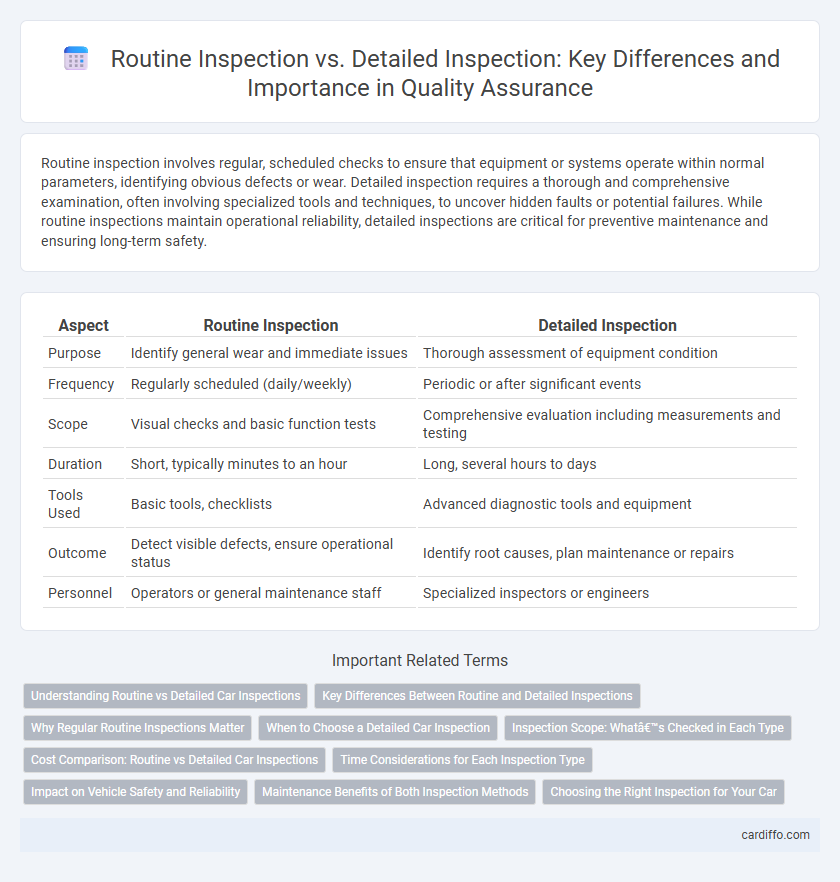Routine inspection involves regular, scheduled checks to ensure that equipment or systems operate within normal parameters, identifying obvious defects or wear. Detailed inspection requires a thorough and comprehensive examination, often involving specialized tools and techniques, to uncover hidden faults or potential failures. While routine inspections maintain operational reliability, detailed inspections are critical for preventive maintenance and ensuring long-term safety.
Table of Comparison
| Aspect | Routine Inspection | Detailed Inspection |
|---|---|---|
| Purpose | Identify general wear and immediate issues | Thorough assessment of equipment condition |
| Frequency | Regularly scheduled (daily/weekly) | Periodic or after significant events |
| Scope | Visual checks and basic function tests | Comprehensive evaluation including measurements and testing |
| Duration | Short, typically minutes to an hour | Long, several hours to days |
| Tools Used | Basic tools, checklists | Advanced diagnostic tools and equipment |
| Outcome | Detect visible defects, ensure operational status | Identify root causes, plan maintenance or repairs |
| Personnel | Operators or general maintenance staff | Specialized inspectors or engineers |
Understanding Routine vs Detailed Car Inspections
Routine car inspections involve basic checks such as fluid levels, tire condition, and brake performance to ensure everyday safety and maintenance. Detailed car inspections go deeper, assessing engine components, electrical systems, suspension, and exhaust for potential issues that require extensive evaluation. Understanding the distinction between routine and detailed inspections helps prioritize maintenance and avoid costly repairs by addressing minor problems early.
Key Differences Between Routine and Detailed Inspections
Routine inspections involve regular, scheduled checks that assess overall condition and identify obvious defects, emphasizing speed and broad coverage. Detailed inspections require thorough, in-depth examination targeting specific components or systems to detect hidden issues, often involving specialized tools and extended time. The key difference lies in the scope and depth, with routine inspections focusing on general maintenance and detailed inspections on comprehensive evaluation.
Why Regular Routine Inspections Matter
Regular routine inspections are essential for early detection of potential issues, preventing costly repairs and ensuring operational efficiency. These inspections maintain safety standards and compliance with regulatory requirements, reducing the risk of accidents or violations. Consistent monitoring through routine checks extends equipment lifespan and enhances overall reliability compared to sporadic detailed inspections.
When to Choose a Detailed Car Inspection
Choose a detailed car inspection when signs of wear, unusual noises, or warning lights appear, indicating potential hidden issues that routine inspections might overlook. Detailed inspections are essential before purchasing a used vehicle or after an accident to ensure comprehensive assessment of mechanical and structural integrity. They involve in-depth evaluation of engine performance, brakes, suspension, and electronic systems for accurate diagnosis and safety assurance.
Inspection Scope: What’s Checked in Each Type
Routine inspection typically covers basic operational parameters such as visual checks, equipment functionality, and safety compliance to ensure everyday performance. Detailed inspection involves comprehensive assessments including internal components, structural integrity, and system diagnostics, often requiring specialized tools and expert knowledge. The scope difference highlights routine inspections addressing surface-level conditions while detailed inspections explore in-depth faults and predictive maintenance needs.
Cost Comparison: Routine vs Detailed Car Inspections
Routine car inspections typically cost between $50 and $100, offering a basic evaluation of essential vehicle systems to detect common issues early. Detailed inspections, priced around $150 to $300, provide a comprehensive analysis including in-depth diagnostics and component testing, leading to higher upfront costs but potentially preventing expensive future repairs. Choosing between routine and detailed inspections depends on the vehicle's age, condition, and risk factors, balancing cost savings with the depth of assessment required.
Time Considerations for Each Inspection Type
Routine inspections typically require less time, often ranging from 30 minutes to an hour, as they focus on general condition assessments and identifying obvious issues. Detailed inspections demand a significantly longer duration, often several hours to a full day, due to their thorough examination of components, measurements, and documentation review. Time allocation for each inspection type depends on factors such as asset complexity, inspection scope, and regulatory requirements.
Impact on Vehicle Safety and Reliability
Routine inspection identifies surface-level issues like fluid leaks, tire wear, and brake performance, ensuring consistent vehicle safety and preventing minor problems from escalating. Detailed inspection examines deeper components such as engine internals, suspension systems, and electrical wiring to detect hidden defects, significantly enhancing long-term reliability. Prioritizing both inspection types optimizes maintenance strategies, minimizing unexpected breakdowns and extending vehicle lifespan.
Maintenance Benefits of Both Inspection Methods
Routine inspection enables early identification of potential issues, reducing downtime and minimizing repair costs through consistent maintenance checks. Detailed inspection provides an in-depth assessment of equipment condition, detecting hidden defects and ensuring compliance with safety standards. Combining both methods maximizes asset reliability, extends machinery lifespan, and optimizes maintenance schedules for cost efficiency.
Choosing the Right Inspection for Your Car
Routine inspections efficiently identify common vehicle issues such as fluid levels, tire pressure, and brake conditions that ensure everyday safety and performance. Detailed inspections involve a thorough examination of critical systems including engine components, transmission, and electrical wiring, useful when diagnosing complex problems or before purchasing a used car. Selecting the right inspection balances cost-effectiveness with thoroughness based on vehicle age, usage history, and specific concerns to maintain optimal driving reliability.
Routine inspection vs detailed inspection Infographic

 cardiffo.com
cardiffo.com